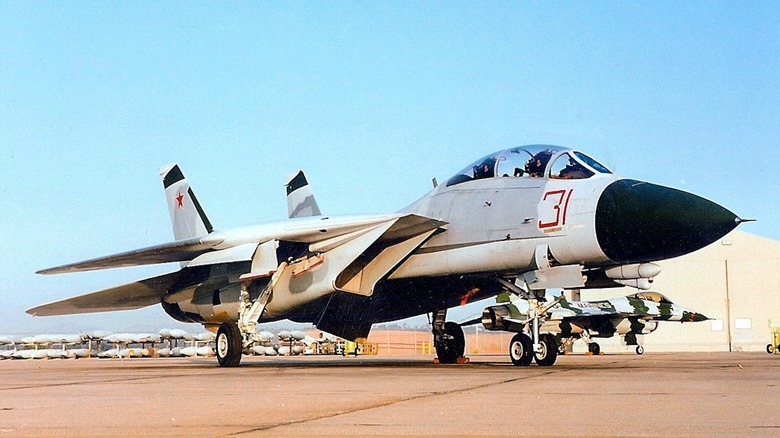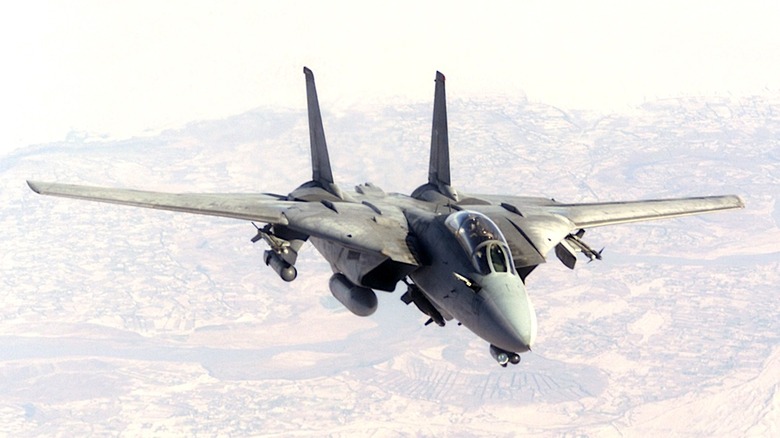Do The Wings Of The F-14 Tomcat Fighter Jet Really Fold?
Though the Grumman F-14 Tomcat fighter jet hasn't officially been a part of the U.S. Naval Fleet for nearly two decades, it remains, arguably, one of the most instantly recognizable craft in existence. That is, of course, largely due to the aircraft's Hollywood closeup, as the Tomcat was the featured mode of warfare for Naval aviator Pete "Maverick" Mitchell (Tom Cruise) and his fighter pilot pals in the 1986 blockbuster "Top Gun."
The Tomcat had been a staple in the Naval fleet long before "Top Gun" made it a household name, with Grumman supplying the U.S. Navy with F-14s for more than two decades between 1972 and 1992. The famed aircraft was reportedly developed amid 1960s Cold War tensions, with the Navy in need of a subsonic fighter jet that could, among other things, hit Mach 2, land and take off from an aircraft carrier, and effectively engage enemy aircraft at high altitudes. Grumman answered the call with the F-14, a game-changing, two-seat fighter that fronted numerous technological advances in terms of weaponry and design elements.
One of the F-14 Tomcat's more outwardly visible advancements was front and center in "Top Gun," though questions arose about whether or not the jet's wings actually could fold in and fold out during flight like they do in the movie. The answer is yes, and the plane's variable geometry sweep wing design was a pretty radical departure from most jets that came before — and largely, even after.
[Featured image by US Navy via Wikimedia Commons | Cropped and scaled | Public Domain]
The F-14's wings adjusted depending on flight conditions
Despite its two-seat capacity, both F-14 occupants were not actually piloting the jet. The rear passenger served as the Radio Intercept Officer (or RIO) and had no control over the Tomcat's iconic folding wings. Instead, they largely functioned using the on-board Standard Central Air Data Computer (or SCADC). However, an F-14 pilot could manually override the system in the event of the SCADC's failure.
If you're curious about what a variable-sweep wing actually does, the design takes inspiration from birds, essentially imitating how nature's O.G. aviators either extend their wings or tuck them back in when they need to slow down or speed up. As it happens, the F-14 was not the first plane to utilize the sweep wing concept, with NASA having used it in the 1950s on the experimental X-5 aircraft. A couple of decades of refinement were needed before the concept was truly ready for use, with General Dynamics' F-111 Ardvark bomber becoming the first U.S. military craft to effectively utilize the tech.
Though the SCADC would control the F-14's wing sweep, according to one engineer who worked on the project, the calculations that went into the system in testing phases "boiled down to slide rules and hard paper calculations." Once the physics were sorted and the SCADC operational, the F-14's wings could sweep anywhere from 20 to 68 degrees depending on flight conditions, bringing the wingspan from 38 ft (collapsed) to 64 ft (extended). Apart from being just a cool-looking way to manage in-flight performance, the F-14's sweeping wings easily rank it among the coolest jets to ever feature in the U.S. Naval fleet — or in a "Top Gun" movie.
[Featured image by SSgt. Michael D. Gaddis, USAF via Wikimedia Commons | Cropped and scaled | Public Domain]

